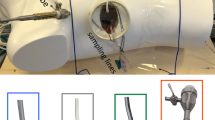Abstract
Background
Carbon dioxide (CO2), with its rapid absorptive nature, has been proven superior to atmospheric air as an insufflating agent in various clinical settings. However, CO2 insufflation has not gained wide clinical acceptance, mainly because there has been no suitable feeding system. The authors therefore have developed a versatile “dual-channel” CO2 insufflator that facilitates wider use of CO2. The objectives of this study were to introduce the authors’ prototype insufflator, to evaluate its safety and performance, and to validate CO2 application using the prototype.
Methods
The prototype insufflator provides one CO2 inlet connected to a regular CO2 gas cylinder and two CO2 outlets positioned on the front and back of the device, respectively. The CO2 gas fed from the cylinder is pressure-regulated and divided into two independent conduits inside the device. The front outlet feeds CO2 gas for pneumoperitoneum at an electronically controlled pressure and flow rate. The back channel supplies CO2 gas at a fixed flow rate, allowing manual control of insufflation for various purposes. The device was evaluated with canine models.
Results
The prototype was safe and performed well. The CO2 application (colonoscopy in this series) using the back channel was feasible while intact CO2 pneumoperitoneum was simultaneously maintained via the front channel. There were no device malfunctions. The serial abdominal x-rays indicated that intraluminal CO2 insufflation such as that used for CO2 colonoscopy caused less residual intestinal gas than conventional air insufflation.
Conclusions
The dual-channel CO2 insufflator enabled two different modes of CO2 insufflation at the same time from a single CO2 cylinder. The authors are now improving the prototype to allow safer and wider usage of CO2 in the operating room.




Similar content being viewed by others
References
Bretthauer M, Thiis-Evensen E, Huppertz-Hauss G, Gisselsson L, Grotmol T, Skovlund E, Hoff G (2002) NORCCAP (Norwegian colorectal cancer prevention): a randomised trial to assess the safety and efficacy of carbon dioxide versus air insufflation in colonoscopy. Gut 50: 604–607
Church J, Delaney C (2003) Randomized, controlled trial of carbon dioxide insufflation during colonoscopy. Dis Colon Rectum 46: 322–326
Nakajima K, Lee SW, Sonoda T, Milsom JW (2005) Intraoperative CO2 colonoscopy: a safe insufflation alternative for localization of colonic lesions during laparoscopic surgery. Surg Endosc 19: 321–325
Sumanac K, Zealley I, Fox BM, Rawlinson J, Salena B, Marshall JK, Stevenson GW, Hunt RH (2002) Minimizing postcolonoscopy abdominal pain by using CO2 insufflation: a prospective, randomized, double-blind, controlled trial evaluating a new commercially available CO2 delivery system. Gastrointest Endosc 56: 190–194
Williams CB (1986) Who’s for CO2? Gastrointest Endosc 32: 365–367
Acknowledgments
This study was supported partly by grants from the Japanese Ministry of Education, Culture, Sports, Science, and Technology. Part of this study was presented at the Society of American Gastrointestinal and Endoscopic Surgeons (SAGES) Emerging Technology Sessions at Fort Lauderdale, FL in April 2005. The authors are most grateful to Takefumi Uesugi, Kenji Noda, and Masakazu Gotanda (Olympus Medical Systems, Tokyo, Japan) for their technical assistance.
Author information
Authors and Affiliations
Corresponding author
Rights and permissions
About this article
Cite this article
Nakajima, K., Yasumasa, K., Endo, S. et al. A versatile dual-channel carbon dioxide (CO2) insufflator for various CO2 applications. Surg Endosc 20, 334–338 (2006). https://doi.org/10.1007/s00464-005-0208-4
Received:
Accepted:
Published:
Issue Date:
DOI: https://doi.org/10.1007/s00464-005-0208-4




